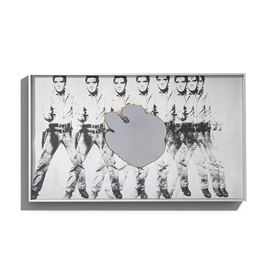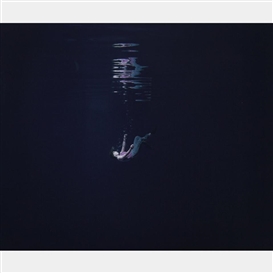TELL ME A STORY
10th MOIS DE LA PHOTO MONTRÉal, CANADA SEPTEMBER 6-OCTOBER 21, 2007 If there were an Academy Award for curating, "Replaying Narrative" ought to win.
Lisa Hunter / Afterimage
01 Jan, 2008

MONTRÉal, CANADA
SEPTEMBER 6-OCTOBER 21, 2007
If there were an Academy Award for curating, "Replaying Narrative" ought to win. This tenth installment of Montreal`s biennial Mois de la Photo is a smart and gorgeous examination of "post-Hollywood" narrative in art. Guest Curator Marie Fraser does more than simply show how cinema and media influence contemporary photography. She asks a larger and more compelling question: what does it mean to tell a story?
Photographers- like filmmakers-have always manipulated images. What is new in the past decade is the tendency to stage photo shoots as if they were film scenes. Among the thirty solo exhibits in "Replaying Narrative" are dozens of such highly cinematic images, such as a man being hit by a car frame-by-frame (by Gustavo Artigas), or an airplane falling out of the sky (by David Claerbout).
Following in the tradition of Jeff Wall and Cindy Sherman, these artists are probably closer to directors than to painters. However, as FVaser`s thoughtful curatorial choices show us, their narratives differ in an intriguing variety of ways.
For starters, many of the artists eschew the proverbial Hollywood ending. They present a scene at its most dramatic moment, when everything hangs in the balance, only to simply abandon their story. That is when things get interesting. As Fraser notes in the catalog for the exhibition, "[W]hat happens when the ending is put off indefinitely and no longer occurs at the end of the narrative? When the narrative is no longer able to effect closure and produce meaning? When it`s no longer the ending that gives the plot meaning? (38).1
Carlos and Jason Sanchez hometown favorites who studied at Montreal`s Concordia University were Mois de la Photo standouts. Not concerned with trying to make their photographs fit into a thematic series, they create one-offs that leave the viewer to imagine the "story." A good example is Abduction (2004). In a windowless attic room, a young girl warily opens a present while a pudgy man kneels beside her bed. Even before you read the title, the scene is already a bit unsettling. Then, without showing any actual violence, the title conjures up in the viewer`s mind scenes and themes far worse than the artists could ever show. In another Sanchez Brothers image, Rescue Effort (2006), "rescuers" pull a mudslide victim out of the ground. Is he alive? Is he dead? Actually, he`s a Stuntman who breathed through a ventilation tube while submerged in a tub of heated mud. No matter. Even for viewers who know the scene is staged, the image evokes the same heart-pounding anxiety as a Hollywood thriller-an anxiety that is never appeased, since we never learn the "ending."
Video artists in "Replaying Narrative" also play with the idea of nonending by distorting narrative sequences so that these stories have no traditional beginning, middle, and end. Stan Douglas`s Klalsassin (2006), for instance, appropriates the narrative model of Akira Kurosawa`s film Rashomon (1950), with its use of different vantage points to describe a murder; but, as Fraser notes, "instead of solving the mystery, [the] contradictory viewpoints make things more confusing and complicated, so much so that a resolution becomes impossible" (42).
Similarly, Douglas Gordon`s film 5-year Drive By (1995) shows John Wayne`s image projected onto a giant drive-in movie screen in the middle of a desert. Gordon slowed John Ford`s classic film The Searchers (1956) so that it would take five years to resolve-longer than even Andy Warhol ever dreamed of making a film last. Each frame of the movie lasts for several hours, giving viewers the impression that they are looking at stills. Even though Gordon appropriates an idealized Hollywood Western, the effect is entirely new and raises interesting questions about the role of plot in storytelling.
Artists like Kelly Richardson do not even bother with the traditional notion of plot. Her work uses cinematic imagery, often from genre films, to "generate a feeling of mystery, but without having anything actually happen" (39). Other artists use Hollywood iconography as a tool to tell new stories. Candice Breitz, for example, reassembles film frames of familiar Hollywood icons such as Clint Eastwood and Sharon Stone to create new narratives from the same images. No footnotes or wall plaques are necessary as our collective knowledge of film culture is similar to the way nineteenth-century audiences were expected to respond to mythological and biblical referencesultimately offering artists a form of visual shorthand.
Interestingly, while many artists appropriate film imagery, Eve Sussman and the Rufus Corporation do the opposite: they make films re-imagining art historical icons such as Jacques-Louis David`s The Intervention of the Sabine Women (1 799). Their work brings the idea of appropriation full circle in "Replaying Narrative." Thus Frascr`s curatorial choices give viewers a holistic and intellectually coherent view of the relationship between cinema and fine art.2
Another notable element of the "Replaying Narrative" exhibitions is the artists who ask whether we are so accustomed to fictional images that we no longer know- or care what is real. Today, many fine art photos have a sense of verisimilitude, even as their scenes are entirely scripted. For instance, Eric Baudelaire`s "war" photos of soldiers and dead bodies were staged on a Hollywood film lot. Other artists` images were created in Photoshop, and yet appear to be "true."
As an interesting foil to the Mois de la Photo, the World Press Photo exhibition was held in Montréal at the same time. Representing the best photojournalism of the past year, the World Press Photo show also featured highly narrative images, such as Beirut socialites surveying bomb damage from the safety of their red sports car (by Spencer Piatt), or emaciated African refugees washing ashore on a beach full of affluent Europeans tourists (by Arturo Rodriguez). The difference is that photojournahsts aren`t allowed to stage or embellish their photographs so their images depend on external stories for meaning. The Mois de la Photo images largely create their own context, their own meaning. Even with the highly theoretical nature of many artworks, "Replaying Narrative" was remarkably accessible. Huge billboards - the type that would normally advertise fashion or movies - sported images of fine art photography throughout the run of the exhibition. In a logistical tour-de-force, exhibitions were mounted in public places all over town. Even people who don`t normally think about photography were surrounded by it, and perhaps intrigued by it. Given the challenges of creating even a small museum show, the success of the multi-venue, multi-artist Mois de la Photo is nothing short of tremendous.
FOOTNOTE
NOTE 1. Mois de la Photo`s accompanying book. Replaying Narrative (Montreal; Mois de la Photo, 2007) provides an excellent selection of images and scholarly essays. However, ils liny type on gray paper is strictly for readers under forty. 2. See Afterimage Vol. 35, no. I (July/August 2007) for a full review of Eve Sussman and the Rujus Corporations video The Rape of the Saisine Women.
AUTHOR AFFILIATION
LISA HUNTER is an arts journalist and author of The Intrepid Art Collector (2006).
COPYRIGHT: Copyright Visual Studies Workshop, Inc. Jan/Feb 2008. Provided by Proquest- CSA, LLC. All Rights Reserved. Only fair use as provided by the United States copyright law is permitted.
PROQUEST-CSA, LLC- MAKES NO WARRANTY REGARDING THE ACCURACY, COMPLETENESS, OR TIMELINESS OF THE LICENSED MATERIALS OR ANY WARRANTY, EXPRESS OR IMPLIED.

 ARTISTS
ARTISTS









